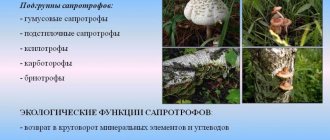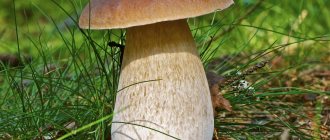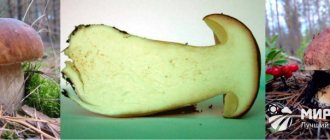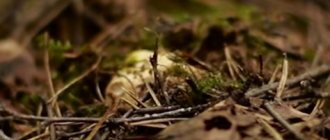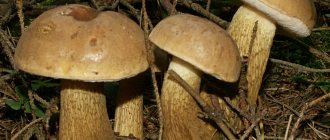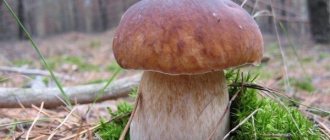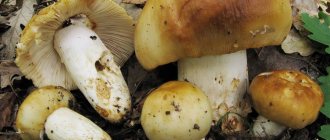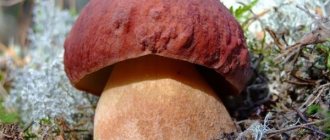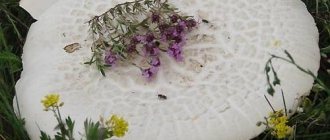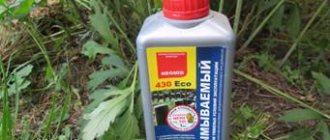The semi-white mushroom has another name - yellow boletus. It is considered a close relative of porcini mushrooms, which are famous for their taste. You can rarely see the yellow boletus, and many people don’t even know about its existence. Mycologists only recently assigned it to a new family Hemileccinum. It is an edible species.
What kind of mushroom looks like a white one, but the cap is yellow underneath. General description of dangerous doubles
For many edible mushrooms, their poisonous or conditionally edible counterparts are known.
The similarity may be strong or superficial. Thus, the porcini mushroom and some of its doubles are absolutely identical in their external characteristics. If you put a double white mushroom in the basket, you can easily get poisoned and, at best, end up in a hospital bed. A mistake in choice can be fatal and lead to a sad outcome. Even mushroom pickers with many years of experience sometimes at first glance cannot distinguish a dangerous double of a porcini mushroom from a real and noble specimen. The edible noble Boletus has its own characteristics and differs both in appearance and in taste.
The main distinguishing feature between edible and poisonous is their chemical composition, which includes toxins.
External signs can be deceptive: for example, the fly agaric loses the white spots on its cap after a good rainfall and becomes like a red russula. The false honey fungus changes the color of its cap with age and becomes even more similar to the real one.
Based on the effects of toxins, insidious false white mushrooms are divided into several categories according to the types of poisoning they cause:
- food intoxication;
- damage to the nervous system;
- fatal poisoning.
Before going into the forest, you should understand how the porcini mushroom differs from its dangerous counterparts. One of the external signs that a person pays attention to is the structure of the hymenophore. Unfortunately, in all representatives of twin species, it is similar in structure to that of the edible original and is spongy. Therefore, it is worth paying attention to changes in its color. You also need to be careful when studying the color of the cut (broken) pulp. True white never changes color when broken, so before putting the fruiting body in a basket, it is better to break off a small piece of it and see what happens.
The mushroom looks like a white one, but yellow. White mushroom - photo and description of how to distinguish a white mushroom from a false one
- Miscellaneous
- Admin
The porcini mushroom is a tubular mushroom from the Bioletaceae family, a genus of boletus. The mushroom is also called: ladybird, capercaillie, feather grass, babka, boletus, yellowtail, cowhorn, pan, bear and others. The white mushroom got its name back in ancient times. Then the mushrooms were very often dried, and after this process the pulp of the porcini mushroom remained perfectly white.
White mushroom - description and photo
The cap of the white mushroom (Boletus edulis) can reach a diameter of 32 cm. It is slightly convex, matte in color, usually yellow, brown, reddish or slightly lemon in color. The center is usually a little darker than the edges of the cap. The cap is shiny and smooth to the touch, sometimes slimy.
The stem of the mushroom reaches a height of 25-28 cm. The color is slightly lighter than the cap and can be reddish or pale brown. The shape is cylindrical, the mesh is white or brown.
The tubular layer of the mushroom is olive or yellowish in color. The layer can be separated from the cap without much effort, small round pores.
The pulp of the porcini mushroom is white and sometimes changes to yellowish.
Where to find it and when it grows: most often, the porcini mushroom is found near very old trees, next to chanterelles, russula, greenfinches, under oaks, birches, and spruces. It appears in July and until the end of September. Most often it is found in wooded areas. It is used in the preparation of various dishes, as the mushroom has excellent taste.
White mushroom (pine) - information and photos
The white pine mushroom (Boletus pinicola) is often found with a cap with a diameter of 6-32 cm. It is matte, with small tubercles and a small mesh. The color is reddish, brown, sometimes purple. In young mushrooms, the shape is similar to a hemisphere; in adulthood, it changes to convex or flat. During rains it is slightly slippery and sticky.
The stem of the mushroom is quite thick, white, short and has a reddish or brown mesh. Its height is 7-16 cm, cylindrical in shape with small tubercles.
The tubular layer is olive or yellow, with regular round pores. The pulp of the pine boletus is fleshy and dense, the smell is very pleasant, and it is white when cut.
Where to find and when it grows: you can look near oaks or pine trees, it also grows in groups near beech trees, spruce trees and chestnut trees. You can find this mushroom in June and until mid-October.
White oak mushroom - photo and description
The white oak mushroom (Boletus reticulatus) has a cap with a diameter of 7-31 cm; in young mushrooms it is spherical, then becomes flat or convex. Color most often: brown, coffee, brown, ocher.
The stem of the mushroom is 8-26 cm high, at first club-shaped, and then becomes cylindrical. There is a white mesh.
The pulp is fleshy, dense, white in color, and does not change when cut. The taste is slightly sweet and the smell is very pleasant.
Where to find and when to grow: grows in deciduous forests, under beeches, lindens, oaks. You can meet the first mushrooms in the month of May.
Birch white mushroom - doubles, where to find
The birch white mushroom (Boletus betulicola) has a cap 6-18 cm in diameter and can be yellowish, white, or ocher. In adulthood, it often becomes flat and smooth.
The stem of the mushroom is up to 13 cm high, brown, solid white. The tubular layer is up to 2 cm long, the pores are small and round. The pulp is tasteless, fleshy and white.
Doubles are considered to be the gall mushroom (Tylopilus felleus), which has a bitterish pulp and meshes on the stalk.
Where to find and when it grows: you can see it near birches, on forest edges. The first mushrooms appear in July and until the beginning of October.
How to distinguish a real porcini mushroom from a false one
The gall mushroom (Tylopilus felleus) or mustard mushroom is considered to be a double of the porcini mushroom. Because of its appearance, mushroom pickers often confuse it with oak mushroom.
The cap of the mushroom is brown or brown in color, convex, thickened, with a diameter of 5-15 cm. The stem is cylindrical, 4-14 cm high, and its finely porous tubular layer is colored gray-white or pinkish. The pulp of the gall mushroom is odorless, fibrous.
The main difference is that if you pick a gall mushroom, it will immediately begin to darken and acquire a brown tint. Also, bitterlings are quite rarely wormy.
Remember that this type of mushroom tastes bitter. Look carefully at the leg, it has a pattern in the form of a brown mesh, but on a real porcini mushroom there is no such mesh.
The gall mushroom grows next to coniferous trees, oaks or birch. Fruits until October, grows in small groups (4-12 mushrooms).
What mushrooms grow in a coniferous forest. Common mushrooms of pine forests.
Pure pine forests grow on very poor sandy soils. The composition of the species of mushrooms found in them depends not so much on the geographical location of the forest, but on its age. In young pine plantings, starting from the second year, late oiler appears. It grows in the grass between rows or under isolated trees.
The yield of oiler increases every year and becomes greatest when the age of planting reaches 10–15 years, and then begins to fade. When the plantings grow so large that the grass disappears and the soil becomes covered with a layer of fallen pine needles, boletus can be found by the tubercles of raised pine needles. Late oiler bears fruit abundantly almost all summer in the same places. Giving 3–4, and in favorable years 5–6 harvests per season.
When pine plantings grow, another abundantly fruiting mushroom appears to replace the late butterfly - greenfinch. Greenfinches grow in large groups and are found in young, middle-aged and mature pine forests, in lowlands among dense shady pine forests. Where they can be found on slightly raised tubercles of fallen pine needles, and in sunlit forest clearings.
In flat areas in pine plantings, the gray row is often found, and a pine variety of porcini mushroom with a yellow-brown cap and a relatively thin, almost cylindrical stalk also grows. The white mushroom usually grows along the edges of plantings, in small depressions and ditches, but is also found among pine trees.
A lamellar mushroom similar to white. Edible and poisonous lamellar mushrooms
Each of us has gone to the forest to pick mushrooms at least once in our lives. Many people know about their valuable properties. Based on their appearance, they are divided into tubular and lamellar.
Lamellar belongs to the basidiomycete group of fungi, which are characterized by the presence of plates (hymenophores) on the underside of the cap. Among them are both edible and poisonous mushrooms.
The structure of a lamellar mushroom
All lamellar mushrooms have an annual fruiting body, which can be either fleshy or leathery. At the bottom of the cap of the mushroom there are plates, which in the form of rays are located from the cap to the stem. Spores ripen on the plates.
There are mushrooms in which the plates do not reach the top of the stem and remain unattached. It happens that the plates form a notch due to the fact that they are rounded at the stem. And in some mushrooms the plate is firmly attached to the stem.
The second part of the mushroom is the stalk, consisting of a large number of thread-like fibers (hyphae). In some mushrooms the stem is a hollow cylinder, while in others the hollow and solid parts are located alternately.
Often in mushrooms of this species, at the beginning of growth, the fruiting body is covered with a special film. During the growth process, the film breaks, part remains on the cap, and the remaining part on the stalk in the form of a vulva. The presence of a vulva (fly agaric) or absence of it (saffron milk caps) will help in determining the type of fungus.
Many mushrooms of the lamellar genus contain juice similar to milk, with a bitter aftertaste. The juice is thick and acrid, clear and watery, usually orange-red in color. There are mushrooms without juice, they are also called crackers because of the dried pulp.
Lamellar mushrooms - edible
They include a wide range of items; prominent representatives of the species include russula, milk mushrooms and rows.
Among the lamellar mushrooms there are a large number of inedible mushrooms that are similar in appearance to edible ones.
Examples: saffron milk cap, chanterelle, champignon, volushka, valui, morel and others.
Mushrooms of the genus lamellar do not have the status of “noble” due to the presence of a large number of inedible representatives. In gastronomic terms, except for honey mushrooms, none of the edible mushrooms are suitable for making soups. But they can be pickled, fried, salted. True, all mushrooms of this type are very fragile and can break during cooking.
There are white lamellar mushrooms, which can be either edible (violin mushroom) or poisonous (false champignon).
Lamellar edible mushrooms can be found in forests and clearings. A certain type of fungus is found in deciduous or coniferous forests, on sandstones or black soils. This species is represented by a huge variety.
Lamellar mushrooms are poisonous
It should be noted that some poisonous lamellar mushrooms can have a quite pleasant appearance and mushroom smell. But, if the mushroom is unfamiliar, then it is better not to put it in the basket. This may be hazardous to your health.
Poisonous ones include: pale toadstool, fly agaric, entoloma, false chanterelle, false honey fungus and others.
Among poisonous mushrooms, toadstool is considered deadly. Once in the body, toxins will make themselves felt only after 7-8 hours, when serious irreversible processes have already taken place inside the body. There is no antidote for poisonous mushrooms, and poisoning often ends in death.
We should not forget that mushrooms are difficult food for the stomach, so they are not recommended for children under 6 years of age, the elderly and people with stomach problems.
Lamellar mushrooms are the most common. They can be collected from spring to late autumn.
Application
This type of mushroom is often used in cooking for frying, pickling and drying. 100 g contains about 35 kcal.
It is also used in folk medicine. Tinctures are often prepared from the semi-white mushroom to strengthen the immune system and treat heart and stomach diseases.
In cooking
Mushrooms are suitable for pickling
The semi-white mushroom has good taste and nutritional qualities. Sometimes it is used raw in first and second courses.
Before cleaning, the mushroom is thoroughly washed and cut to check for worms. Semi-white mushrooms are most delicious when marinated. To remove bitterness, mushrooms are soaked for at least 1 hour and then boiled for 30 minutes in salted water. After this preliminary procedure, the yellow boletus is ready for pickling.
Recipe description:
- fresh yellow boletus - 1 kg;
- water - 400 ml;
- vinegar - 100 ml;
- onion - 1 head;
- sugar - 1 tbsp. l.;
- salt - 2 tbsp. l.;
- Bay leaf;
- pepper, cloves.
Peeled, chopped mushrooms are boiled in water with bay pepper for 30 minutes. Then put it in a separate container, add salt, sugar and spices to the broth. The liquid is put on fire. When it boils, add vinegar and mushrooms. Boil for another 15 minutes, periodically skimming off the foam. Place onions and mushrooms at the bottom of the jars, add marinade and store in the refrigerator.
First courses with the addition of this mushroom are also delicious. Description of the recipe for cream soup with yellow boletus:
- fresh mushrooms - 150 g;
- potatoes - 100 g;
- heavy cream - 100 ml;
- onion - 1 head:
- water - 1 l;
- vegetable oil - 30 ml;
- garlic, salt, pepper - to taste.
Finely chopped potatoes are fried in a saucepan with oil. Then transfer to a saucepan, add onions, mushrooms and a clove of garlic, add water and cook for another 20 minutes. After this, everything is crushed (pureeed) using a blender, poured back into the saucepan, cream, salt, pepper are added and brought to a boil.
In medicine
Regular consumption of porcini mushroom helps prevent the development of tumors, stroke and heart attack. This is especially useful after surgery during the recovery period.
Mushroom extract is used externally to treat skin diseases. Regularly wiping your facial skin helps make it clean and velvety. Dried mushroom powder is used to treat wounds. Damaged areas of the skin are sprinkled with it several times a day until complete healing. To strengthen the immune system and cure sexual disorders, use the tincture.
Recipe description:
- Dry mushrooms are ground into powder in a coffee grinder or spice grinder. Add 2 tbsp. l. sugar and 40 ml of vodka.
- The tincture is stored in the refrigerator. Take 2 times a day 30 minutes before meals.
For the treatment of varicose veins and thrombophlebitis, an alcohol tincture is prepared. The washed and dried mushrooms are placed in a liter jar, filling it to the top. Then pour in alcohol, close with a nylon lid and leave to infuse for 2 weeks. This medicine is rubbed into the affected areas 2 times a day, the treatment period lasts 2-3 months.
Gall mushroom. Description of the gall fungus
In appearance, bitter mushroom resembles a porcini mushroom. The diameter of the cap of the false porcini mushroom is 4-10 centimeters, sometimes it can reach 15 centimeters.
The cap has a hemispherical shape, but as it grows it becomes rounded, cushion-shaped and spread out. The surface layer is finely fibrous, initially pubescent. In wet weather the surface becomes sticky. The color of the cap can be yellow-brown, light brown, gray-ocher or dark brown.
The height of the gall fungus stalk ranges from 3 to 12.5 centimeters, with a thickness of 1.5-3 centimeters. Its shape is cylindrical or club-shaped, the base of the fibrous structure is swollen. The color of the leg varies from cream to yellow-brown. The upper part of the leg is creamy yellow or whitish, while a distinct dark brown, brown or blackish mesh is clearly visible. The leg is massive and strong, filled with whitish pulp.
When cut, the flesh turns red. The taste of the pulp is bitter, the smell is weak. The pulp of the bitter mushroom is practically never wormy, which is why the mushroom looks attractive. The tubular layer adheres to the stalk. At first the tubes are whitish in color, but then become pink and dirty pink. The pores are angular or round in shape, and when pressed they turn red or brown.
The spore powder is pinkish or pinkish-brown. The spores are smooth, ellipsoidal in shape, without color or gray-pink tone.
Places where the false porcini mushroom grows
Gall fungi form mycorrhizae with deciduous and coniferous trees. Most often they grow in coniferous forests, on fertile acidic soils, sandstones and light loams. They are often found on the bases of trees and rotten stumps.
False porcini mushrooms grow on all continents. They bear fruit from June to October, but with early frosts, fruiting may end in September. They live in small groups or individually. These are quite common mushrooms in central Russia; they can be found in any region of our country.
What mushrooms are gall mushrooms confused with?
Young hare mushrooms have colorless pores, so they are confused with boletus mushrooms, but the former do not have scales. In addition, the gall mushroom is similar to the boletus mushroom, but it can be distinguished due to its darker color and mesh on the stalk.
Mushroom with yellow flesh. Family Ramariaceae – Ramariaceae
Ramaria yellow (yellow hornet, lemon yellow coral, sulfur yellow coral, stag mushroom)
Ramaria flava (Fr.) Quel.
Soil saprophyte
The fruit body is up to 20 cm in diameter and 10-15 cm high. Sometimes it reaches an impressive weight (1.5-2 kg). The mushroom has all shades of yellow: cream, apricot-yellow, later ocher or almost orange. When pressed, the color of the fruiting body changes to wine-brown. The pulp is moist, the smell is herbal. The stalk is thick, divided into branching processes. Yellow hornet can be found in damp-shady places of deciduous, coniferous and mixed forests, especially in lichen pine forests, among the cover of green mosses in August-September. Settles in large groups, forming rows or arcs. Grows directly on the ground or on rotten wood. The mushroom is very similar to golden ramaria.
Preparation. It is edible when young; later its flesh becomes coarse. Used fried and boiled.
Golden ramaria (golden hornet)
Ramaria aurea (Schaeff.: Fr.) Quel.
Soil saprotroph
The fruit body is massive, 15-20 cm in diameter, 8-10 cm in height, bushy, abundantly branched, ocher-yellow, golden-yellow or golden-ocher with a lighter base, fading when dry. The “twigs” are thick, densely spaced, their ends are blunt, cut 2-3 times. The leg is short, whitish at the base. Many branched horns diverge from one common root. It grows on the soil in coniferous, occasionally deciduous forests, often among mosses. Fruits from July to October. A close relative of the golden ramaria is the yellow ramaria (Ramaria flava). The two species are difficult to distinguish without laboratory analysis. Their nutritional value is the same.
Cooking. Edible mushroom. It is eaten fresh. These mushroom “noodles” can be boiled and added to mushroom stir fry for a flavor bouquet.
Ramaria Invala (Invala rogatik)
Ra maria eumorpha (Karst.) Corner (Syn. Ra maria invalii (Cott. et Wakef.) Donk.)
Litter saprotroph, xylotroph
The fruit body is bushy with branched ends, 2-8 cm high, yellow-brown or ocher-brown in color, slightly bitter taste, with a sour odor. It grows on litter or in whole clumps, forming whole rows, arcs or witches' circles on dead trees in coniferous and deciduous forests. It occurs frequently, annually in July-September. After boiling, the mushroom is quite edible, but it is rarely collected.
Beneficial features
The semi-white mushroom has a wide range of beneficial properties. It contains amino acids and vitamins that are essential for the functioning of the body. Nutritional value of boletus:
- water - 86.4;
- mono- and disaccharides - 1.11;
- unsaturated fatty acids - 0.41;
- saturated fatty acids - 0.41;
- ash substances - 0.93;
- dietary fiber 3-3.21.
The microelements contained in these mushrooms help strengthen hair, restore skin tone and normalize thyroid function. Vitamins A, B and zinc help relieve fatigue, cope with stress and nervous tension.
False white mushroom. How to distinguish a porcini mushroom
Contrary to popular belief, it is indeed possible to confuse porcini mushrooms with their poisonous counterparts, despite the fact that boletus mushrooms differ significantly from other species. And although the white mushroom has only two doubles and they rarely lead to death, you still need to know how to distinguish the white mushroom from the false double.
In this article we will look at the characteristic features of real porcini mushrooms, and also consider its most common counterparts with external features and photos that will help to accurately determine edibility. Using our tips, you can avoid the danger of poisoning and do not put a poisonous mushroom in the basket.
How to distinguish a porcini mushroom
The porcini mushroom is considered the most valuable find for any mushroom picker, because boletus mushrooms are good in any form. They retain their taste and unique aroma fried, boiled, pickled and dried.
There are several edible species. Each of them has its own characteristics, but all species share some common qualities that will help you quickly distinguish an edible specimen from a poisonous one. Firstly, the pulp of a good specimen has a pleasant characteristic odor, or is completely devoid of aroma. Secondly, boletus mushrooms do not change the color of the flesh when broken or cut (Figure 1).
Note: The only exception to the rule is Polish, which looks very similar to regular white, but when cut or pressed the flesh quickly turns blue.
In addition, all edible boletus mushrooms have a characteristic shade of the tubular layer (the inside of the cap). It should be white, yellowish or olive. Any other shades indicate that this is a poisonous specimen.
Figure 1. External features of a real boletus
Since white has only two counterparts - gall and satanic, we will look at the characteristics of these species in more detail, and their photos will help to accurately identify the mushroom even during collection. This way you will protect yourself and your loved ones from food poisoning.
Gall or false porcini mushroom: description and photo
The popular name of the species, bitterling, most accurately defines its main feature. The fact is that its pulp is so bitter that forest animals and even insects do not eat bitter. And a person is unlikely to be able to accidentally eat a gall mushroom, because after heat treatment its bitterness only intensifies.
Note: Some mushroom pickers claim that after a long soaking (about 12 hours), the unpleasant bitter taste goes away and it can be eaten. However, we do not recommend conducting such experiments, since according to recent data, even after soaking, toxins remain in the pulp that can cause serious liver damage.
